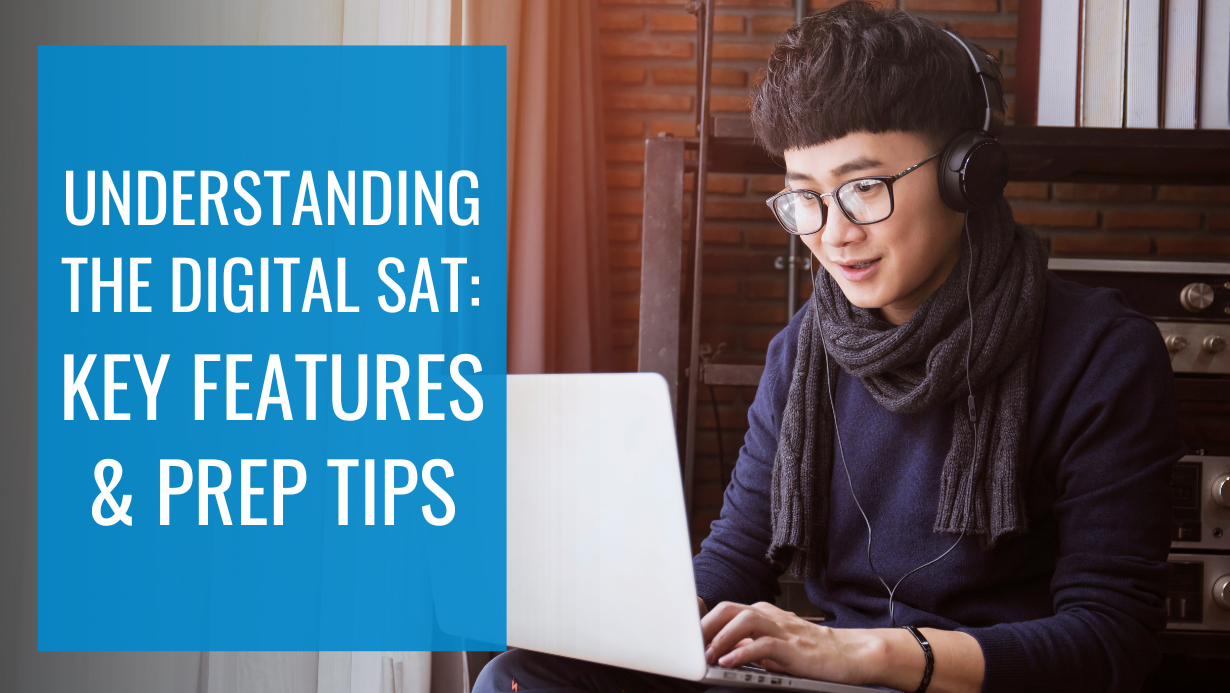The College Board transitioned to the fully digital SAT format in 2024, making it the standard for students worldwide. You’ll find that the structure and content of the new test is different than the paper-based version that most people are familiar with. No longer will the test be the same for all students on a given national test date; instead, the test will be unique for each student, regardless of when or where the test is taken.

Now that students and educators have adapted to this format, understanding its features is key to effective preparation. Let’s walk through everything you need to know about the digital SAT.
Why the Digital SAT Matters Today
Greater Flexibility For College Board
Administering a digital test provides much more flexibility as society moves into a new age of digital learning. While there won’t be a total free-for-all (no, you won’t be able to take the SAT while lounging in your bed), there will be greater flexibility regarding when and where students can take the SAT. This benefits the College Board, as they work to prevent any further test cancellations and provide equal access for students.
More Opportunity For Rural And Low-Income Students
This flexibility will also benefit students in areas that traditionally see less testing equality. Some high schools host an in-school SAT test day providing an opportunity for all students to take the SAT at least once, regardless of their personal situation. Without in-school testing, some students would never take the SAT. With the move to a digital test, we’ll see more schools opting for an in-school test option as they will no longer have to comply with the very specific national testing dates. This is possible because each student’s test will be unique, so there will no longer be a concern about students’ sharing test questions or answer sheets.
Increased Security
The security of paper-based exams has been questioned in recent years. The all-digital version eliminates particular security concerns associated with paper exams changing hands and needing to be shipped across the U.S. to scoring centers.
Prevent Testing Fatigue
Many students have expressed concern over the years with the sheer length of the SAT which clocks in at three hours, leading to an exhausting environment that can lead to testing fatigue. This new version of the SAT will help to eliminate some of this by reducing the test length to two hours and 15 minutes.
What Is Staying The Same?
The SAT’s scoring scale, tested material, and scholarship opportunities continue to provide a stable framework for students planning their college admissions journey.
Scoring Scale
In 2016, we saw the most significant changes to the SAT in history. One of the biggest changes was that the test moved from a 2400 scale to 1600. But rest easy because the SAT is not changing the scoring scale again. The digital test will continue to be scored on a 1600-point scale.
Testing Locations
In general, testing locations will remain the same; students will either be able to take the test in school or at a local testing center. While the test is now conducted digitally, it will still require proctoring in a controlled setting. However, we may see an increase in schools offering the SAT in school, during school hours, as this new test version provides them greater flexibility in exactly when and how the test is administered by the schools.
Tested Material
The paper version and the digital SAT will assess comparable skills, knowledge, and content areas broken down into the Reading & Writing (ERW) and Math (M). On the new digital exam, the below content areas will be tested on:
| Reading & Writing Content Domains | Math Content Domains |
| Information and Ideas Craft and Structure Expression of Ideas Standard English Conventions | Algebra Advanced Math Problem Solving and Data Analysis Geometry and Trigonometry |
The SAT’s goal will remain the same: to provide an indication of a student’s college readiness.
Scholarship Opportunities
Many students rely on the PSAT/NMSQT to qualify for the National Merit Scholarship program. The process for this will not change. The entire suite of SAT Assessments, including the PSAT, has moved to a digital format in the fall of 2023. The change in test format does not affect a student’s ability to qualify for the National Merit Scholarship or any other scholarship program using PSAT scores.
Accommodations
Testing accommodations will continue to be awarded to students who qualify. The only change here may be that some students could be awarded the accommodation of using a paper-based SAT rather than a digital version.
The College Board will continue to offer accommodations such as extra testing time, help translating questions, or a separate testing room. Whatever the College Board deems a fair equalizer due to a disability will continue to be awarded to eligible students.
To find out if you’re eligible for accommodations on the SAT, contact your school or a college admissions counselor for a list of proper documentation to send to College Board for approval.
Unique Features of the Digital SAT
Format
Ditch those #2 pencils. Instead, you’ll need a personal or school-issued device. If you don’t have one, one will be provided for you. If you need to rent a device to take your exam you can request a device after you complete your testing registration.
Test Length
This is a big one. The SAT will be shorter with the digital version by about an hour. It will also provide a countdown on the test itself, so you can keep an eye on the time. This will help eliminate interruptions from proctors to provide timing warnings. The test will be shorter because it will feature shorter reading passages and fewer reading questions.
Multistage Adaptive Testing (MST)
The digital SAT is moving to a multistage adaptive methodology. In a digital, adaptive SAT, each test section (Reading and Writing / Math) is divided into two modules. Students answer a set of questions in the first module before moving on to the next. The questions in the second module are determined based on performance in the first module. This means that the test “adapts” to show questions that are more appropriate to a particular student’s performance level.
The benefits of the MST model:
- Maintains assessment precision with fewer test questions as compared to the current SAT, allowing for shorter tests that nonetheless retain the reliability of longer ones.
- Permits a higher level of control over administered content than question-by-question adaptive models.
- Covers content and addresses skills and knowledge in ways similar to what is found on the current SAT.
- Allows students to review (and possibly change) their responses to previously administered questions within the same stage.
Calculators
The SAT math section will now allow the use of a calculator on every question. A calculator will be built into the digital testing experience, or you can opt to use your physical calculator if you prefer. Instead of testing arithmetic skills, the focus will be placed on mathematical reasoning skills.
Score Delivery
No longer will testing centers have to manually package up and ship physical tests. This will drastically reduce score delivery timelines. Expect to get your scores faster with the digital SAT, which is great news for you! The sooner you have your scores, the sooner you can decide to retest, confirm your Early Decision school choice, or determine whether you want to submit your score to colleges or universities.
After-Test Resources
The SAT will soon offer an enhanced post-test suite of resources for students. You’ll find College Board will provide relevant resources such as a list of trade schools, community colleges, universities, and even career paths based on your scores. You will also get a more in-depth breakdown of your scores that should help you make a more informed decision about your next steps.
Final Thoughts – The SAT Is Going Digital
As the SAT continues in its digital format, students should focus on familiarizing themselves with its adaptive structure and leveraging its faster score delivery to plan their college applications effectively. Some of the impacts to a student’s test prep strategy are:
- The test will be shorter by about an hour.
- Students will be able to use a calculator on every math question.
- The test will be unique for every student. There will not be a single version of the SAT for each national testing date.
We recommend taking your first SAT in the fall of junior year allowing for plenty of time to re-test if needed in the following spring. Be sure to look at the calendar and decide in advance when you’ll be taking the SAT. To help increase your score, you can always consider 1:1 standardized test tutoring to benefit from a stronger foundation.
We recommend you reach out if you need assistance with your college applications. In the meantime, happy studying!
Source: https://highered.collegeboard.org/media/pdf/digital-sat-faculty-guide-ada.pdf
Originally published in March 2022, edited and updated by one of our admissions consultants, and republished in December 2024

Former Assistant Director of Admission at Rice University
4 Years in Rice University Admission
14,000+ Applications Read and Evaluated
Jessica has her Bachelor of Business Administration in Marketing from The University of Texas. She also completed her MBA while working full time in the Office of Undergraduate Admissions at her alma mater before transitioning to Rice University. As a first-generation college graduate, she is passionate about helping students apply to their dream schools.



